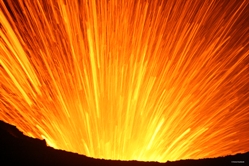
DEGASSING
Terrence Gerlach of the Cascades Volcano Observatory (USGS) explains that volcanoes do, of course, emit CO
2 from the degassing of magma. In the absence of humans, they are the major source for restoring CO
2 lost from the atmosphere and ocean by silicate weathering, and the deposition and burial of carbonates and organic carbon. Subaerial and submarine volcanoes are estimated to emit between 0.18 and 0.44 Gt CO
2/year (1 Gigaton = 1 billion tonnes). The preferred average is 0.26 Gt CO
2/year, which is dwarfed by the 35 Gt CO2/year now emitted by human activities.
These volcanic emissions are comparable to the 0.2 Gt CO
2/year emitted by the flaring of waste gases, the 0.22 Gt CO
2/year emitted from a couple of dozen 1000Mw coal-fired power stations (equal to c. 2% of the world’s coal-fired electricity generating capacity), or the annual CO
2 emissions from individual countries like Pakistan or Poland. So, the human-induced CO
2 emissions estimated for 2010 - 35 Gt - were 135 times greater than the 0.26 Gt CO
2/year estimated from volcanoes of all sorts.
Gerlach calls this ratio the ‘Anthropogenic CO2 Multiplier’ (ACM) – an index of the dominance of anthropogenic over volcanic CO
2 emissions. The ACM rose gradually from around 18 in 1900 to 38 by 1950, then rapidly to its present level of 135 (Gerlach supplies error bars for those interested in a higher level of detail). This change reflects the exponential rise in documented CO
2 emissions from the burning of fossil fuels.